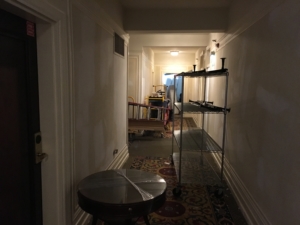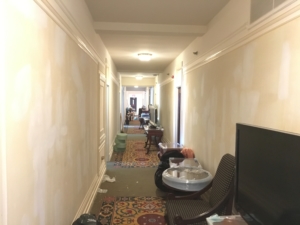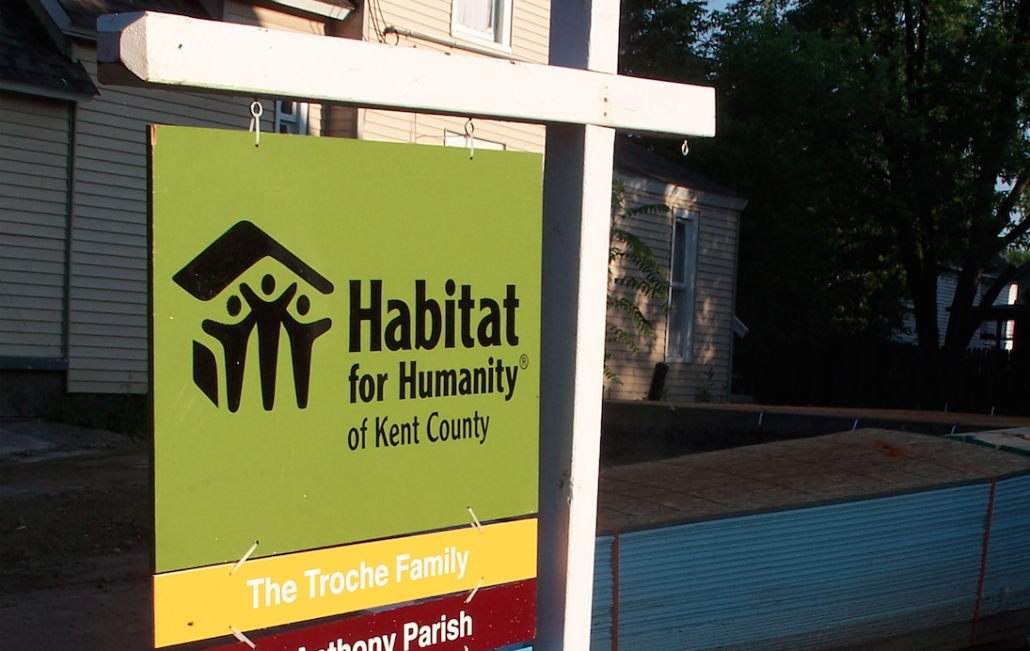Written By: Madalyn Buursma
We stuck out like a sore thumb against the grandeur of the Amway Grand Hotel; in our steel toed boots, our big work coats, tool bags in hand. A kind Amway hotel employee in a suit greeted us, thanking us for coming. They were glad the furniture — some of which were original to when the hotel opened in 1913 — from the hotel rooms on the eighth floor could have use in the community, he told us.
I had met the group of thirteen or so Habitat for Humanity volunteers just a few minutes earlier, along with WMEAC’s executive director, Bill Wood. We were there for a professional material recovery, sometimes called deconstruction. Habitat for Humanity will often partner with local business or private homes to take out furniture, appliances, or other materials, to then make use of in other ways.

I was paired up with a lovely retired woman, who had started volunteering for Habitat for Humanity two months ago. We carefully put foam strips on the corners of the beautiful coffee tables, paintings on the walls, and TVs, before wrapping them with cling wrap and moving them into the hall. Other teams were going through and collecting the items, to later be put on moving vans.
Habitat for Humanity Kent County has worked for the past three years doing material recovery. They have removed close to 1,000 kitchens, along with various professional removals like the material recovery in the Amway Grand, John Marek, Associate Director of Construction Operations told me.
During the material recovery, things like TVs and tables go to one of their three Kent County ReStores, and usable building materials are processed into their construction warehouses. The organization helps people build and improve their homes.
“We believe affordable housing plays a critical role in strong and stable communities,” their website says. The homes that they build only use new products, Marek explained, because of warranties: but used products can be used in their rehab and gut remodels.
Deconstruction and material recovery has many environmental benefits, Bill Wood said. He first got into deconstruction many years ago, while living in Washington State. He had recently graduated from college, and needed a job: he found one working on a four person crew doing deconstruction for an environmental advocacy organization, who made money through the deconstruction program. Later, after he got connected with the executive director of Habitat for Humanity in Kentucky during graduate school, he helped set up a new deconstruction program.
The West Michigan Sustainable Business Forum estimates that construction and demolition materials make up 11 percent of items put in the landfill. Some things coming out of a construction site could be at the end of their life. But a lot of things, like a two by four plank of wood or half a bucket of paint, can be recycled for more uses.
When that happens, not only is it being kept out of the landfill, but energy is also saved, because it takes energy to make news material. If “you could grow the reuse market, you could cut down on the demand for new material and it’s going to help reduce … fossil fuel emissions, and it’s going to reduce the amount of carbon,” Wood said.

Not only is Habitat for Humanity benefiting the environment with their material recovery program, they are also giving back to the community.
“Spending six to seven hours every day with the public is a wonderful way to spread the essence of our mission, ‘Seeking to put God’s love into action, Habitat brings people together to build homes, communities and hope,’” Marek said. “That spirit pervades our work, our attitudes, and in fact gives us the energy to do what we do. It’s very rewarding to struggle for something we feel is good for our community.”
After a couple of hours, we took a lunch break to eat pizza in one of the empty suites: “So we’re eating a private meal in the Amway presidential suite, yeah?” joked one volunteer. After lunch, Bill Wood and myself had to leave, but the volunteers would continue the project for the rest of the day, and would come back to finish up the next day.
Their work does have its challenges, Marek said, but each volunteer who helps them and each business or home who donates their items are helping the community.
“That’s what this is: us helping us,” he said. “The Material Recovery program at Habitat for Humanity Kent County is important because it’s a method to improve our surroundings through opportunities to give, opportunities to donate, and opportunities to protect our environment.”
Cover photo courtesy Habitat for Humanity of Kent County


